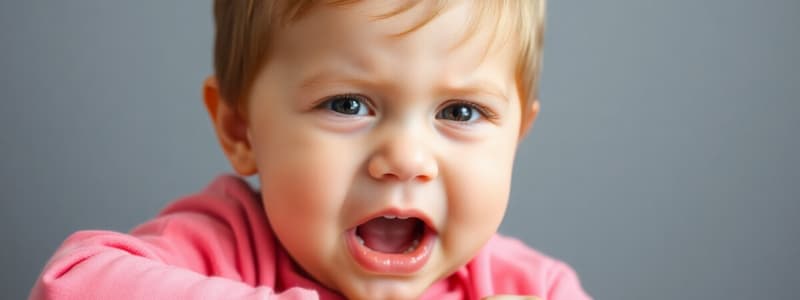Podcast
Questions and Answers
What is a primary contribution of emotion regulation skills in children?
What is a primary contribution of emotion regulation skills in children?
How do attachment needs change for children after the age of 5?
How do attachment needs change for children after the age of 5?
Why is secure attachment important for children in middle childhood?
Why is secure attachment important for children in middle childhood?
Which attachment styles are associated with higher levels of peer rejection in children?
Which attachment styles are associated with higher levels of peer rejection in children?
Signup and view all the answers
What role do fathers play in the attachment system as children grow older?
What role do fathers play in the attachment system as children grow older?
Signup and view all the answers
What factors contribute to the visibility of children in social settings?
What factors contribute to the visibility of children in social settings?
Signup and view all the answers
How is aggression generally viewed in the context of social status among children?
How is aggression generally viewed in the context of social status among children?
Signup and view all the answers
What happens to the perception of aggression by the time children reach 8th grade?
What happens to the perception of aggression by the time children reach 8th grade?
Signup and view all the answers
What type of aggression is assessed through questions about psychological tactics like ignoring peers?
What type of aggression is assessed through questions about psychological tactics like ignoring peers?
Signup and view all the answers
Which group of children is more likely to have friendships that improve wellbeing?
Which group of children is more likely to have friendships that improve wellbeing?
Signup and view all the answers
What aspect of visibility is associated with negative feelings like loneliness, despite achieving visibility goals?
What aspect of visibility is associated with negative feelings like loneliness, despite achieving visibility goals?
Signup and view all the answers
What is suggested about the stability of aggression in children over the years?
What is suggested about the stability of aggression in children over the years?
Signup and view all the answers
What is the focus of the article by Brown (2000)?
What is the focus of the article by Brown (2000)?
Signup and view all the answers
Which psychological concept is linked to prosocial behavior according to Christner et al. (2020)?
Which psychological concept is linked to prosocial behavior according to Christner et al. (2020)?
Signup and view all the answers
What main advantage does animal-assisted therapy provide according to Charry-Sánchez et al. (2018)?
What main advantage does animal-assisted therapy provide according to Charry-Sánchez et al. (2018)?
Signup and view all the answers
What association is primarily discussed by Cillessen & Mayeux (2004)?
What association is primarily discussed by Cillessen & Mayeux (2004)?
Signup and view all the answers
What developmental issue is addressed in the meta-analysis by Compas et al. (2017)?
What developmental issue is addressed in the meta-analysis by Compas et al. (2017)?
Signup and view all the answers
In the study by Choe et al. (2013), what bias is examined among young school-age children?
In the study by Choe et al. (2013), what bias is examined among young school-age children?
Signup and view all the answers
What relationship is explored in the study by Colle & Del Giudice (2011)?
What relationship is explored in the study by Colle & Del Giudice (2011)?
Signup and view all the answers
What is the primary concern according to the CDC's message for cat owners regarding toxoplasmosis?
What is the primary concern according to the CDC's message for cat owners regarding toxoplasmosis?
Signup and view all the answers
What aspect of childhood development does Crick (1996) primarily focus on?
What aspect of childhood development does Crick (1996) primarily focus on?
Signup and view all the answers
What is the primary focus of the study by Rood et al. (2009)?
What is the primary focus of the study by Rood et al. (2009)?
Signup and view all the answers
Which factor is suggested as a risk for anxiety disorders in childhood according to Rosenbaum et al. (1993)?
Which factor is suggested as a risk for anxiety disorders in childhood according to Rosenbaum et al. (1993)?
Signup and view all the answers
What concept does Salovey and Mayer (1990) contribute to the field of psychology?
What concept does Salovey and Mayer (1990) contribute to the field of psychology?
Signup and view all the answers
Which study focuses on racial identity and social cognition during middle childhood?
Which study focuses on racial identity and social cognition during middle childhood?
Signup and view all the answers
What is the main subject of the publication by Rosenthal (2016)?
What is the main subject of the publication by Rosenthal (2016)?
Signup and view all the answers
What is a key outcome discussed by Schneider et al. (2001) regarding child-parent attachment?
What is a key outcome discussed by Schneider et al. (2001) regarding child-parent attachment?
Signup and view all the answers
Which publication emphasizes the development of emotional competence?
Which publication emphasizes the development of emotional competence?
Signup and view all the answers
Which theory is central to the work of Ryan and Paquette (2009)?
Which theory is central to the work of Ryan and Paquette (2009)?
Signup and view all the answers
What do Salmon et al. (2016) investigate in relation to child psychopathology?
What do Salmon et al. (2016) investigate in relation to child psychopathology?
Signup and view all the answers
How do the changes in friendship dynamics from Stage 4 to Stage 5 influence the perception of sharing responsibility in relationships?
How do the changes in friendship dynamics from Stage 4 to Stage 5 influence the perception of sharing responsibility in relationships?
Signup and view all the answers
What role does prosocial behavior play in the development of reciprocal friendships among children?
What role does prosocial behavior play in the development of reciprocal friendships among children?
Signup and view all the answers
What outcome might result from the lack of explicit discussions about prosocial behavior in early childhood?
What outcome might result from the lack of explicit discussions about prosocial behavior in early childhood?
Signup and view all the answers
What implication does the distinction between spontaneous and reported friendship behaviors have on understanding children’s friendships?
What implication does the distinction between spontaneous and reported friendship behaviors have on understanding children’s friendships?
Signup and view all the answers
What is a key finding about the impact of parental relationships on children’s peer friendships?
What is a key finding about the impact of parental relationships on children’s peer friendships?
Signup and view all the answers
What characterizes an individual with shallow or deficient affect?
What characterizes an individual with shallow or deficient affect?
Signup and view all the answers
Which behavior best illustrates a lack of remorse?
Which behavior best illustrates a lack of remorse?
Signup and view all the answers
How does a lack of empathy manifest in an individual?
How does a lack of empathy manifest in an individual?
Signup and view all the answers
What does a general unconcern about performance indicate?
What does a general unconcern about performance indicate?
Signup and view all the answers
Which of the following would typically not apply to someone who is considered callous?
Which of the following would typically not apply to someone who is considered callous?
Signup and view all the answers
What is the significance of metacognitive skills in children's learning?
What is the significance of metacognitive skills in children's learning?
Signup and view all the answers
Which statement best describes private self-consciousness in children?
Which statement best describes private self-consciousness in children?
Signup and view all the answers
How do self-awareness abilities benefit children in social situations?
How do self-awareness abilities benefit children in social situations?
Signup and view all the answers
What aspect of self-concept involves how children perceive their abilities in various domains?
What aspect of self-concept involves how children perceive their abilities in various domains?
Signup and view all the answers
What is public self-consciousness primarily concerned with?
What is public self-consciousness primarily concerned with?
Signup and view all the answers
Study Notes
Middle Childhood Socioemotional Development
- Children develop emotional competencies, including awareness of their own and others' emotions, empathy, and coping abilities.
- Emotional competence develops within the context of relationships and culture.
- Expectations for emotional competence may differ for girls and boys.
- Emotional communication within relationships is important for adjustment.
- Psychotherapy with children helps them achieve greater emotional competency.
Emotional Awareness of Self and Others
- The first step in emotion regulation is recognizing one's own emotional state and naming it.
- Emotional self-awareness correlates with cognitive abilities.
- Lower emotional awareness predicts internalizing problems like depression and anxiety.
- Children's ability to recognize and name emotions in others improves with age.
- Recognition of happiness and sadness is easier for children than other emotions.
Emotions and Externalizing Symptoms
- Callous-unemotional (CU) traits are emotional deficits in children.
- CU traits are associated with difficulties in regulating emotions and understanding others' emotions.
- Externalizing behaviors involve acting out emotions through antisocial behavior, hostility, and aggression.
- Children with externalizing problems may have low emotional knowledge or understanding of others' emotions.
Emotions and Internalizing Symptoms
- Internalizing behaviors (anxiety and depression) are acted in, not out.
- The behavioral inhibition system leads to feelings of anxiety and fear.
- Children who are more sensitive to cues of threat are more prone to internalizing problems.
- Offspring of adults with internalizing disorders tend to be more behaviorally inhibited.
Emotion Regulation in Middle Childhood
- Supportive parental reactions encourage emotional regulation.
- Warm, responsive parents validate children's emotions, help them make sense of their reactions, and accept emotions as part of life.
- Non-supportive parental reactions might limit a child's ability to regulate emotions.
- Emotional regulation means adaptively managing emotions.
Attachment and Caregiving
- Attachment is a secure base for a child to explore the world.
- Secure attachment to parents correlates to better academic and social outcomes in middle childhood.
- Children in middle childhood gain autonomy but still need support from caregivers.
- Friendships are a context for children to practice caregiving.
- Prosocial behavior and assertiveness determine friendship quality.
Friendship During Middle Childhood
- Children actively choose their friends based on factors like gender, race, and personality.
- Similarity in traits and interests are strong factors determining friendship choices.
- Children develop more complex understanding of friendships over time, from mutual activities to shared intimacy and moral commitments.
- Feelings of kindness, acceptance, and empathy are important in friendships.
Moral Cognition or Moral Reasoning
- Kohlberg's stages describe how moral reasoning develops in children and adults.
- Preconventional morality is focused on self-interest and avoiding punishment (Stages 1-2).
- Conventional morality is focused on pleasing others and obeying rules (stages 3-4).
- Postconventional morality involves abstract reasoning and ethical principles (Stages 5-6).
Moral Self-Concepts
- Moral self-concepts develop in middle childhood, forming the basis for identity.
- Moral self-concepts link moral values to perceptions of self.
- Shame and guilt are associated with failing to live up to moral values in children.
Summary of Social and Emotional Development During Middle Childhood
- Emotional awareness and regulation increase in proficiency throughout childhood.
- Attachment to parents and social emotional growth are intertwined.
- Children's self-concepts, especially in terms of gender, race, and ethnicity, become significant during this stage.
Studying That Suits You
Use AI to generate personalized quizzes and flashcards to suit your learning preferences.
Related Documents
Description
Explore crucial topics in child development related to emotion regulation and attachment. This quiz dives into how children's attachment styles evolve, the impact of fathers, and the perception of aggression. Test your understanding of these vital concepts and their implications on child wellbeing.




